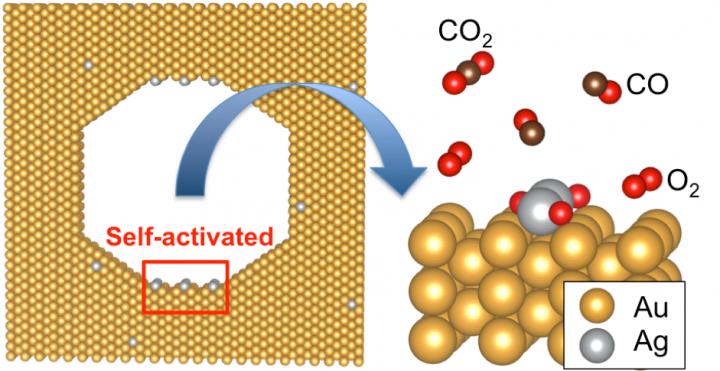Hope for new catalysts with high activity

This is an active structure in a nanoporous gold catalyst. Credit: Osaka University
Gold is a metal that is chemically inactive and does not corrode, but nanoporous gold (NPG), with its sponge-like structures, acts as a catalyst to promote chemical reactions such as carbon monoxide (CO) oxidation. Its mechanisms, however, remained unclear.
Osaka University scientists elucidated the activation mechanism of NPG catalysts that made poisonous CO gas harmless. Their research results were published in Nature Communications.
The researchers performed in situ analysis using atomic-scale resolution environmental transmission electron microscopy (ETEM) equipped with a high-speed camera, clarifying the catalytically active structure of NPG in low-temperature CO oxidation. They succeeded in visualizing self-activation on the surface of a nanostructured catalyst. ETEM observation and computer simulations revealed that this nanostructure contained residual impurities, which played an important role in catalyzing chemical reactions.
Lead author Naoto Kamiuchi said, “The results of our study will provide a clue to the clarification of reaction mechanisms of various solid catalysts used for industrial purposes, leading to the development of new highly active catalysts necessary for solving energy issues.
###
Osaka University was founded in 1931 as one of the seven imperial universities of Japan and now has expanded to one of Japan's leading comprehensive universities. The University has now embarked on open research revolution from a position as Japan's most innovative university and among the most innovative institutions in the world according to Reuters 2015 Top 100 Innovative Universities and the Nature Index Innovation 2017. The university's ability to innovate from the stage of fundamental research through the creation of useful technology with economic impact stems from its broad disciplinary spectrum.
Website: http://resou.
Media Contact
All latest news from the category: Life Sciences and Chemistry
Articles and reports from the Life Sciences and chemistry area deal with applied and basic research into modern biology, chemistry and human medicine.
Valuable information can be found on a range of life sciences fields including bacteriology, biochemistry, bionics, bioinformatics, biophysics, biotechnology, genetics, geobotany, human biology, marine biology, microbiology, molecular biology, cellular biology, zoology, bioinorganic chemistry, microchemistry and environmental chemistry.
Newest articles

First-of-its-kind study uses remote sensing to monitor plastic debris in rivers and lakes
Remote sensing creates a cost-effective solution to monitoring plastic pollution. A first-of-its-kind study from researchers at the University of Minnesota Twin Cities shows how remote sensing can help monitor and…

Laser-based artificial neuron mimics nerve cell functions at lightning speed
With a processing speed a billion times faster than nature, chip-based laser neuron could help advance AI tasks such as pattern recognition and sequence prediction. Researchers have developed a laser-based…

Optimising the processing of plastic waste
Just one look in the yellow bin reveals a colourful jumble of different types of plastic. However, the purer and more uniform plastic waste is, the easier it is to…



